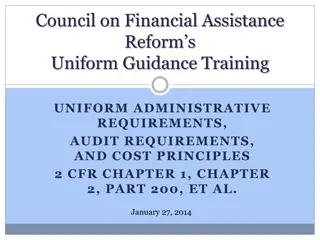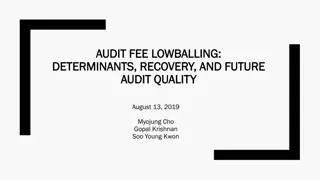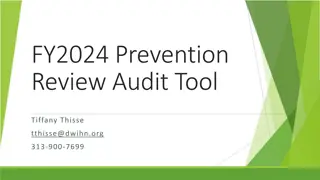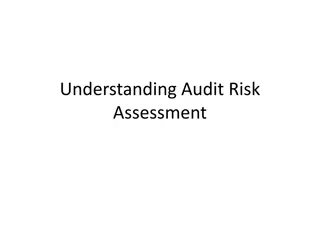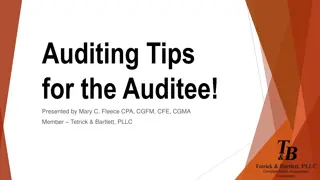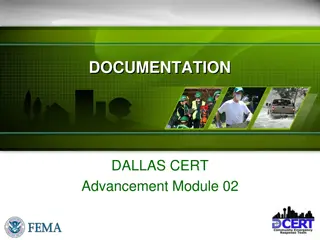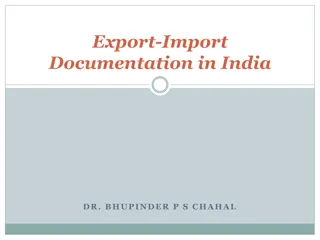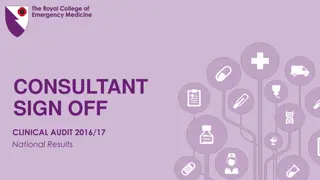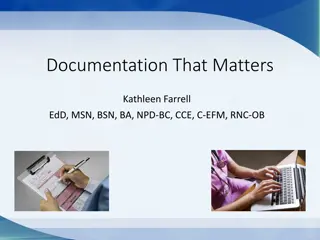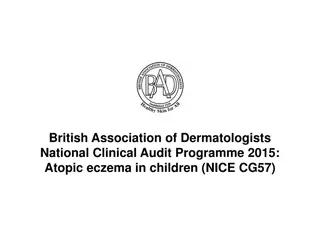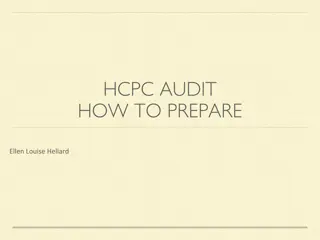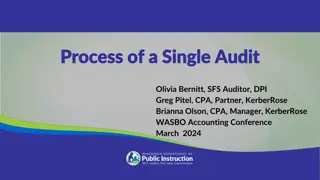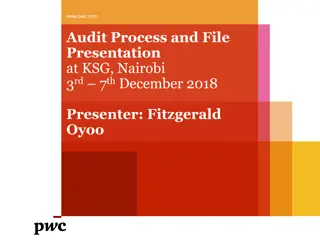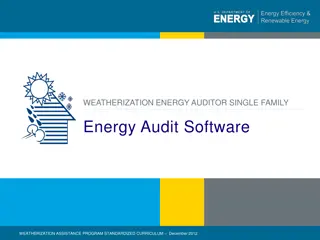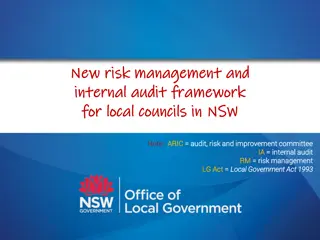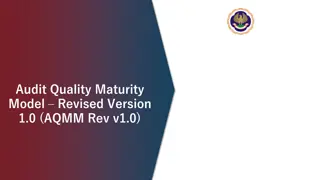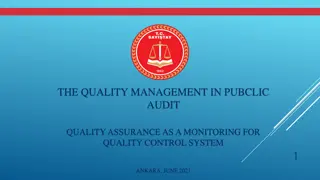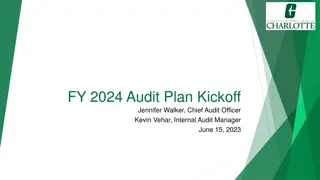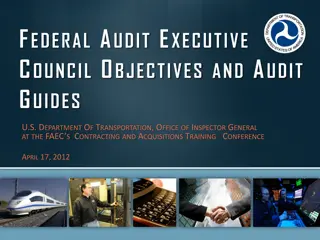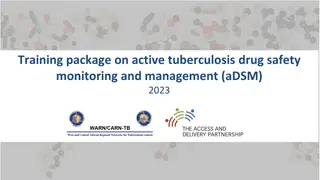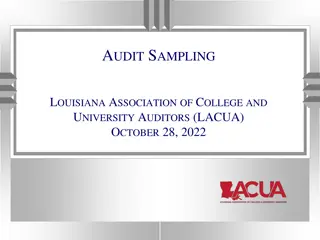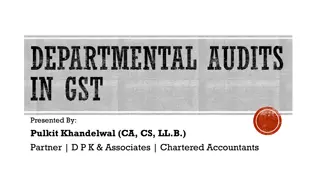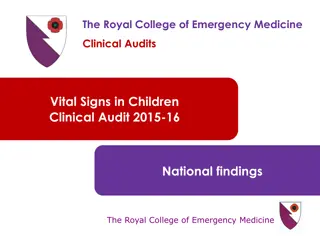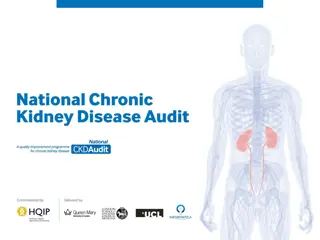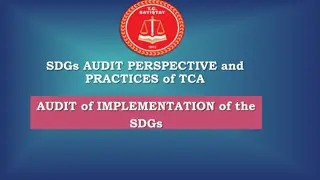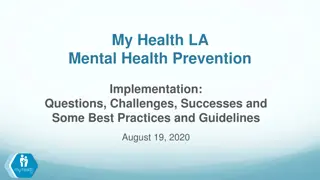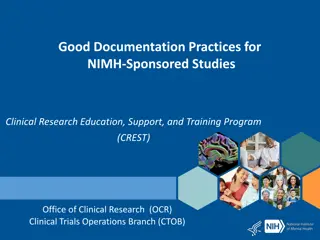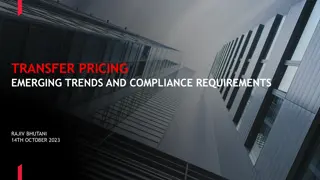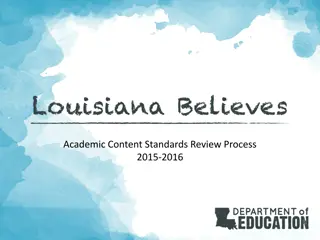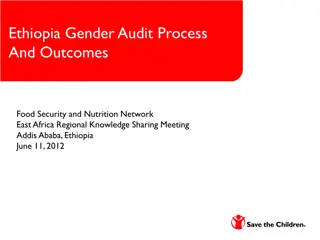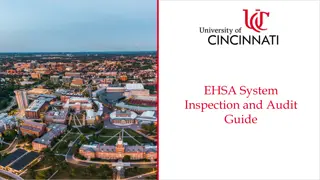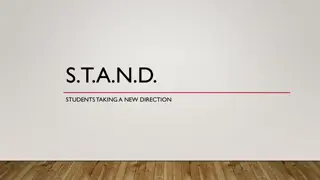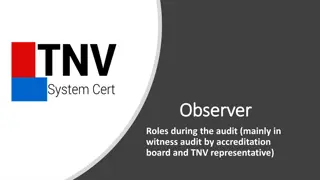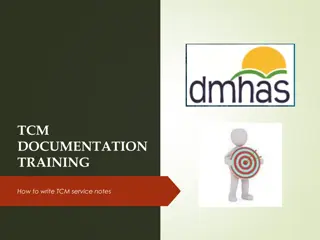Comprehensive Documentation and Standards for Prevention Program Review and Audit
This comprehensive documentation outlines standards and examples for reviewing and auditing prevention programs. It covers organizational structure, staff development, ADA policies, supervisor qualifications, subcontractor compliance, Governing Board requirements, LARA certifications, and prevention plan standards. The content includes detailed examples, documentation requirements, and specific measurable goals. It provides a thorough framework for ensuring the effectiveness and quality of prevention programs.
Uploaded on Sep 30, 2024 | 0 Views
Download Presentation

Please find below an Image/Link to download the presentation.
The content on the website is provided AS IS for your information and personal use only. It may not be sold, licensed, or shared on other websites without obtaining consent from the author. Download presentation by click this link. If you encounter any issues during the download, it is possible that the publisher has removed the file from their server.
E N D
Presentation Transcript
FY2024 Prevention Review Audit Tool Tiffany Thisse tthisse@dwihn.org 313-900-7699
Program and Employee Operations STANDARDS DOCUMENTATION EXAMPLES 1. There is a chart outlining the organizational structure. 1. Organizational structure chart 2. There is a staff development/training policy/program that includes: (a) Staff Orientation: All new personnel are trained with regard to their responsibilities, program policy and operating procedures. (b) Staff Training: Identification of staff training needs, provide in-service training, continuing education and staff development activities 2. Staff development/training policy/program, Employee Handbook, Orientation form, Training tracing form 3. There are specific policies/procedures regarding the Americans with Disabilities Act (ADA) requirements for employees requiring reasonable accommodation and how the requests are processed 3. Americans with Disabilities Act (ADA) policy 4. There is evidence of the Prevention Program Supervisor s: (a) Job description or contract agreement. (b) Michigan Certification Board of Addiction Professionals certification. (c) Highest level of education completed. 4. Supervisor s job description/contract, MCBAP cert., highest completed education (diploma or transcript)
Program and Employee Operations STANDARDS DOCUMENTATION EXAMPLES 5. If applicable, there is a policy/procedure for ensuring subcontractors comply with DWIHN standards/expectations. 5. Subcontractor Policy, subcontractor s contract 6. There is evidence that the make-up of the Governing Board is publicly posted (including via website notification) and updated at least annually 6. Organizational structure chart 7. Copy of LARA license/other certification 7. The organizational certification/licensure is up to date for the services the agency provides.
Prevention Plan STANDARDS DOCUMENTATION EXAMPLES 1.There is a current Prevention Plan. 1.Current Prevention Plan (strategic plan, service plan, work plan) 2.The Prevention Plan documents specific services and supports to be provided including the amount (how much), scope (to whom/where), and duration (date(s)/for how long) of services. 2.Ensure all 3 areas are in the Prevention Plan 3.The Prevention Plan includes measurable (specific numbers/dates/locations) and realistic steps for the goals and objectives. 3.Ensure that there are specific numbers and dates in the Prevention Plan 4.There is evidence the Prevention Plan is reviewed at least annually to evaluate the effectiveness of the program and the services offered. 4.Quality review meetings, Annual reports, Quarterly Reports
Prevention Plan Examples Amount Scope Duration (for how long) Measurable (how much/many) (to whom/where) 10 groups/sessions 20 participants 500 attendees 15 members 1000 flyers 2 events Target Population and Program Description and Scope of Service (SOW) Zip Codes/Cities Schools/grades Ethnicity Risk level Language Gender Age Social/Economic situation Fiscal year School year Date range Specific date(s) Objectives/Primary & Secondary Intended Outcomes (SOW) 5% increase 10% decrease 95% completion rate 1000 flyers distributed 2 additional members 1 additional school
Prevention Plan Examples DESCRIPTION OF SERVICES/ ACTIVITIES OTHER STRATEGY TYPE/ CODE ESTIMATED (PLANNED) OUTPUTS PERSON RESPONSIBLE TARGETS/ TIME METHOD OF EVALUATION & EXPECTED OUTCOME Provide 45 SUD presentations in the city of Detroit. Education 45 Outputs (45 x 1) Staff name/ Position Oct. 2021 - Sept. 2022 The content learned will be evaluated by presentation-specific objectives. 85% of attendees demonstrate an understanding of the presentation s learning objectives, increase their knowledge level of the topic, are better able to access information or resources related to the topic. Mock Crash: Implement 1 mock crash demonstration for 150 high school seniors and present the mock crash video to 2,603 high school students that were not able to attend. Implement 11 series of Botvin s Life Skills (LST) Program to Middle School youth at Harper Woods Middle School and Grosse Pointe Middle Schools. This series consists of 8 classroom sessions of 1 hour duration. Education 2,603 Outputs (1 Day x 2,603) Staff name/ Position May 2022 Audience Response System (ARS) surveys created by the epidemiologist will be used to evaluate program results. A 20% increase in perceiving danger/risk in ATOD use is expected. Education 88 Outputs (11 x 8 x 1) Staff name/ Position Oct. 2021 - May 2022 Botvin LST Pre-Post Test will be used to evaluation program results on all program indications. A minimum of 5% increase is expected on the indicators of anti-drug and life skills knowledge, pro smoking and pro-drinking attitudes and Life Skills assessment Provide technical assistance and provide guidance for coalition, 172 sessions Community 258 Outputs (172 x 1.5) Staff name/ Position Oct. 2021 - Sept. 2022 Coalition Internal Assessment- Coalition effectively employs at least 2 prevention strategies to address identified areas of impact.
Prevention Plan Examples Description Measurable Goal Amount Scope Duration The content learned will be evaluated by presentation-specific objectives. 85% of attendees demonstrate an understanding of the presentation s learning objectives, increase their knowledge level of the topic, are better able to access information or resources related to the topic. Audience Response System (ARS) surveys created by the epidemiologist will be used to evaluate program results. A 20% increase in perceiving danger/risk in ATOD use is expected. SUD Presentations 45, one hour presentations Adults in the City of Detroit Oct. 2021 - Sept. 2022 Mock Crash 1 mock crash demonstration for 150 high school seniors and present the mock crash video to 2,603 high school students that were not able to attend Highschool Students May 2022 Botvin LST Pre-Post Test will be used to evaluation program results on all program indications. A minimum of 5% increase is expected on the indicators of anti-drug and life skills knowledge, pro smoking and pro- drinking attitudes and Life Skills assessment Coalition Internal Assessment- Coalition effectively employs at least 2 prevention strategies to address identified areas of impact. Botvin s Life Skills 11 series of 8, one hour sessions Middle Schools Oct. 2021 - May 2022 Coalition technical assistance and guidance 172, one and a half hour sessions Coalitions members and service area Oct. 2021 - Sept. 2022
Quality Improvement STANDARDS DOCUMENTATION EXAMPLES 1. There is a Quality Improvement/Quality Assurance policy/plan. 1. Quality Improvement/Quality Assurance policy/plan 2. The Quality Improvement/Quality Assurance policy/plan is reviewed/updated annually. 2. Signed and dated policy, meeting minutes when it was reviewed/approved 3. There is evidence the Quality Improvement meetings are held according to the agency s policy. 3. Quality meeting minutes for the quarter reviewed (can be incorporated into other meetings if the minutes include a quality section) 4. There is evidence that the program evaluates the degree to which it is meeting its goals and objectives. 4. Meeting minutes, Quarterly Reports, other quality reports 5. There is evidence of Pre and Post tests/surveys. 5. Examples of tests/surveys (can be redacted) 6. If services are offered virtually, there is evidence of a teleservices policy to assure that the use of telecommunication/virtual modalities are in accordance with applicable laws. 6. Teleservices/telehealth/virtual services policy, how remote/virtual services are provided 7. If staff are working remotely, there is evidence of a policy to ensure that staff are aware if their responsibilities and expectations while not in the office. 7. Remote/telecommuting/virtual work policy, staff expectations when not working in the office or community
Outreach Services/Care Coordination STANDARDS DOCUMENTATION EXAMPLES 1. There is evidence of collaborative relationships that are documented by formal agreements (i.e., Memorandums of Agreement or Understanding). 1. Memorandums of Agreement or Understanding (MOA/U), contracts, (must be signed by both parties) 2. There is evidence of coordination and collaboration with other coalitions. 2. Meeting agendas/minutes, flyers of joint activities/events, MOA/U 3. There is evidence of coordination of resources and activities with other primary prevention providers, such as local health departments, community collaboratives, and MDHHS's prevention programs for women, children and families, and older adults. 3. Flyers of joint activities/events, resource guides, referral forms, MOA/U (Department of Human Services, Housing, Michigan Rehabilitative Service, Work First, etc.) 4. There is evidence the services provided are based on a formal local needs assessment. 4. Formal Needs Assessment 5. If applicable, there is evidence of SYNAR tobacco prevention activity. 5. MRL list, vendor education, compliance checks
Record Keeping STANDARDS DOCUMENTATION EXAMPLES 1.There is evidence of sign-in/sign-out sheets for each activity provided. 1.Sign-in/sign out sheets 2.There is evidence of an activity log identifying the: (a) Group's name. (b) Type of service. (c) Date of service. (d) Time in and out. (e) Address or virtual. (f) Staff s name and credentials. (g) Contact person to verify the activity (preferably external to the agency). (h) Number of recipients. 2.DWIHN's MPDS Activity Log, spreadsheet, internal activity logs, etc. 3.The following NOMS data is being accurately reported in the MPDS Activity Logs and system entries: (a) Age. (b) Gender. (c) Race. (d) Ethnicity. (e) Number of evidence-based programs and strategies. 3.DWIHN's MPDS Activity Log, Quarterly Reports
Record Keeping STANDARDS DOCUMENTATION EXAMPLES 1.The MPDS Activity Logs match the MPDS entries. 1.DWIHN's MPDS Activity Log, spreadsheet, internal activity logs, etc. 2.The prevention activities are entered into MPDS by the FSR submission date. 2.https://mpds.sudpds.com/ 3.There is evidence that the staff/program maintains a work calendar showing scheduled activities/meetings/trainings that corroborate with the MPDS entries. 3. Outlook, Google, desk calendar, planner 4.The Quarterly Reports are completed and submitted to the Prevention Services Manager (Karra Thomas). 4.Quarterly Report
Individual Records STANDARDS DOCUMENTATION EXAMPLES 1.There is evidence that direct prevention services are aligned with evidence-based curriculum/models. 1.The name/description of the curriculum used 2.If providing individual services, the annual Consent to Prevention programs is current, dated, and signed by the recipient. 2.Annual Consent form
Cultural Competency STANDARDS DOCUMENTATION EXAMPLES 1.There is a Cultural Competency policy/plan. 1.Cultural Competency plan 2.There is evidence prevention interventions are consistent with cultural, ethnic, and/or racial beliefs or values. 2.Evidence Based programs description, Cultural Competency plan 3.There evidence of Non-Discrimination against any employee, applicant for employment, Member or other person, or any applicant for receipt of Service Provider's SUD Services, with respect to hiring, tenure, terms, conditions or privileges of employment, programs and Services provided, or any matter directly or indirectly related to employment and/or Services, or Service delivery and access because of race, color, religion, national origin, ancestry, age, sex, height, weight, marital status, or physical or mental disability, or genetic information that is unrelated to the individual s ability to perform the duties of the particular job or position. 3.Non-Discrimination policy or a statement included in another policy
Limited English Proficiency (LEP) STANDARDS DOCUMENTATION EXAMPLES 1. There is a Limited English Proficiency (LEP) Policy that complies with the Office of Civil Rights Policy Guidance on the Title VI Prohibition against Discrimination, Title VI of the Civil Rights Act of 1964, and the Patient Protection and Affordable Care Act. 1. Limited English Proficiency Policy 2. The Limited English Proficiency (LEP) Policy offers access to interpreter services of all languages, free of charge to the participant. 2. Limited English Proficiency Policy 3. The Limited English Proficiency Poster is clearly displayed for accommodations for the hearing impaired. 3. I Speak poster 4. There is evidence of brochures, booklets, outreach, recruitment information, or other materials routinely disseminated to the public that includes statements about services available and the right to free language assistance services. 4. Statement on brochures, fryers, website, etc. 5. Reading Level: Provider has a method to ensure all informational materials, including those describing consumer rights, service requirements and benefits are provided in a manner and format that may be easily understood. Informational materials are written at the 6.9 grade reading level. 5. MS Word accessibility review www.wordcalc.com/readability/ datayze.com/readability-analyzer readabilityformulas.com/readability-scoring- system.php
Emergency Preparedness Plan STANDARDS DOCUMENTATION EXAMPLES 1.There is an Emergency Preparedness Plan. 1.Emergency Preparedness Plan 2.The Emergency Preparedness Plan has written protocols to respond to the following situations: (a) Medical Emergencies (b) Fire Emergencies (c) Natural Emergencies (d) Severe weather such as tornadoes (e) Chemical Disasters (f) Bomb Threats/Terrorism (g) Active Shooter Incidents 2.Emergency Preparedness Plan and any other supplemental documents 3.There is evidence all personnel complete initial training on the organizational emergency plan. 3.Emergency Preparedness Plan, orientation form, training list
Confidentiality STANDARDS DOCUMENTATION EXAMPLES 1.There is a Confidentiality/Privacy policy. 1.Confidentiality/Privacy policy 2.There is evidence all records are kept in a secure area. 2.Site visit, photo of storage system 3.If applicable, there is evidence that Release(s) of/for Information were completed, signed, and dated as appropriate. 3.Release of Information form
Communicable Diseases STANDARDS DOCUMENTATION EXAMPLES 1.There is a Communicable Disease/Infection Control policy/plan. 1.Communicable Disease/Infection Control policy 2.There is a procedure for bio waste management/clean-up. 2.Bio waste management/clean-up policy if not included in the Communicable Disease/Infection Control policy 3.There is evidence that all employees received training regarding Communicable Disease/Infection Control. 3.Training list, orientation form, Communicable Disease/Infection Control policy 4.There is evidence of a plan for continuity of care in the event of pandemics, epidemics, and/or COVID-19. 4.COVID 19 policy if not included in the Communicable Disease/Infection Control policy
Recipient Rights STANDARDS DOCUMENTATION EXAMPLES 1. There is a Recipient Rights policy/plan. 1. Recipient rights policy 2. There is evidence that the Recipient Rights Policy is reviewed annually. 2. Signed and dated policy, meeting minutes when it was reviewed/approved 3. There is evidence the Recipient Rights advisor has received training on the on the recipient rights procedures. 3. Name of advisor and current Improving MI Practices SUD Recipient Rights Training 4. There is a policy for client rights and protections, including information about the right to file grievances and appeals, the requirements and time frames for filing a grievance or appeal, the availability of assistance in the filing process, the toll-free numbers that consumers can use to file a grievance or an appeal by phone, the right to a State Fair Hearing, and the fact that benefits can continue if requested by the consumer pending an appeal or hearing decision. 4. Recipient rights policy
Recipient Rights STANDARDS DOCUMENTATION EXAMPLES 5. The Rights Complaint forms are available and accessible. 5. Rights Complaint forms 6. The Substance Abuse Rights Poster with the appropriate names and numbers of the agency s Recipient Rights advisor and DWIHN Rights Consultant is visible in public view. 6. Site visit, photo of the poster 7. The Know Your Rights pamphlets are in common areas and available to recipients. 7. Site visit, photo of the Know Your Rights pamphlets 8. Policies ensure that consumers are free to exercise their rights in a manner that does not adversely affect their services. 8. Recipient rights policy
Charitable Choice STANDARDS DOCUMENTATION EXAMPLES 1.Does the provider self-identify as a religious (or faith-based) organization? 1.Self report 2.There is evidence the program beneficiary receiving services who objects to the religious character of a program has a right to notice, referral, and alternative services which meet standards of timeliness, capacity, accessibility, and equivalency and ensuring contact to this alternative provider. 2.Charitable Choice Policy or statement 3.There is a policy/procedure to address the following areas for services not covered: (a) Inform the PIHP prior to any action. (b) Notify participants of services not covered. 3.Charitable Choice Policy or statement
The Golden Golden Thread
Staff: Initial Qualifications STANDARDS DOCUMENTATION EXAMPLES 1. There is evidence of the initial date of hire. 1. Offer letter, Employer Letter, HR Document/Form 2. There is evidence of the termination date, if applicable. 2. Termination letter, HR record 3. There is evidence that the staff person was age 18 or older on the hire date. 3. Driver's license, state identification card, passport 4. There is evidence that a criminal background check was completed prior to the date of hire. 4. ICHAT (N/A if hired before 2014) 5. There is evidence of the highest level of education completed by this staff member. 5. Diploma or transcript of: High School completion, GED, College Degrees 6. There is evidence that staff working with minors received an MDHHS Central Registry Clearance. 6. MDHHS Central Registry Clearance letter 7. There is evidence of an Employment Eligibility Verification ("I- 9") form. 7. Completed I-9 form 8. There is evidence that staff met the requirement for completion of an Employer Hosted New Employee Orientation within 30 days of hire. 8. Orientation form
Staff: Ongoing Job Qualifications STANDARDS DOCUMENTATION EXAMPLES 1. There is evidence the current Job Description is present, signed, and dated by the employee. 1. Signed and dated Job Description 2. There is evidence of a signed and dated Annual Performance Appraisal. 2. Signed and dated Annual Performance Appraisal (N/A for staff employed under a year) 3. There is evidence that an annual criminal background check was conducted. 3. ICHAT (N/A for staff employed under a year) 4. There is evidence that the staff person is properly certified to perform direct services. 4. CPS/CPC, Development Plan through MCBAP, CHES, Evidence of Specifically Focused training 5. There is evidence that the staff member has the license, certification, registration, and/or education that match their job description. 5. Job Description match credentials and education 6. There is evidence of monthly HHS Office of Inspector General (OIG) Clearance for this staff member. 6. Screenshot/PDF of dated check from exclusions.oig.hhs.gov 7. There is evidence of monthly GSA Exclusion List Clearance for this staff member. 7. Screenshot/PDF of dated check from SAM.gov
Staff: Required Trainings STANDARDS FREQUENCY 1. Cultural Competence/Diversity training (previously Cultural Competence: A Foundation Course) 1. Biennially 2. HIPAA (Basics) training 2. Triennially 3. Medicare & Medicaid Compliance Training (Previously Corporate Compliance) 3. Annually 4. Abuse & Neglect: Reporting Requirements training 4. Biennially 5. Anti-Harassment & Non-Discrimination Training 5. Biennially 6. Emergency Preparedness training 6. Triennially 7. Medicaid Fair Hearings, Local Appeals and Grievances training 7. Biennially 8. Human Sex Trafficking (Previously Child Sex Trafficking in America) training 8. Biennially
Staff: Required Trainings Cont. STANDARDS FREQUENCY 9. Limited English Proficiency (LEP) training 9. Triennially 10. "Improving MI Practices" - Recipient Rights (SA) training 10. Annually 11. "Improving MI Practices" or "CHAG"- Communicable Diseases training 11. Annually 12. "CHAG" Communicable Diseases (Level II) training 12. Annually 13. "Improving MI Practices" - The Basics of Confidentially training 13. At hire 14. Naloxone (Narcan) Training 14. Biennially 15. MCBAP approved Prevention Ethics training 15. Once




